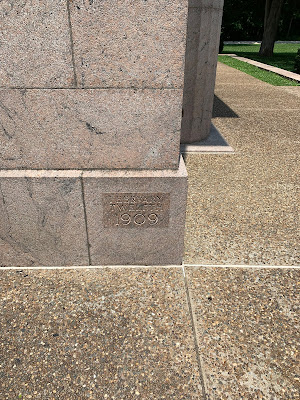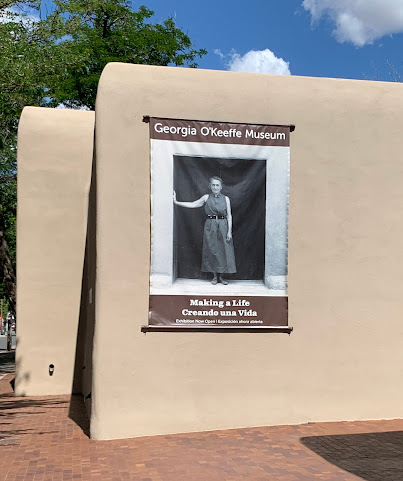We made our way east and landed back in Kentucky. Last time we were here we missed the Lincoln Childhood sites so we made a point to visit this time.
In December, 1808 Thomas Lincoln paid $200 cash for the 300 acre Sinking Spring Farm. The young family moved there from nearby Elizabethtown shortly before Abraham was born. The spring made the land a good home site, but stony, clay soil made farming difficult.
Abraham Lincoln was the first president born west of the Appalachian Mountains. His birth in a log cabin at Sinking Spring Farm took place on February 12, 1809 when that part of Kentucky was still a rugged frontier.
We went inside the visitor's center and viewed some amazing artifacts.
This is very, very cool
Being a family researcher, I found this very interesting - Abraham Lincoln's family tree. After the first Lincolns settled in Massachusetts, not one generation was born and died in the same place. Abraham Lincoln, the seventh generation of his family in America, would become the first President born outside of the thirteen original states.
His parents.
Thomas Lincoln, 1778-1851
Nancy (Hanks) Lincoln, 1784-1818
The Lincoln Family.
Nancy holding Abraham, Thomas, Sarah
Unfortunately, the original log cabin where Lincoln was born is believed to no longer be in existence. However, after the Sinking Spring Farm was purchased for $3,600 in 1906, the first Lincoln Memorial was erected between 1909 and 1911 atop the knoll where legend (and some deeds with Thomas Lincoln's name) lead experts to believe Abraham Lincoln was born. The now largely forgotten monument was once national news. More than 100,000 people - many of them school children - gave an average of 31 cents each to create the memorial.
President Theodore Roosevelt laid the memorial cornerstone on February 12, 1909, the 100 year anniversary of Lincoln's birth and President William Howard Taft dedicated the building in 1911. President Woodrow Wilson accepted the site as a national park in 1916, President Franklin Roosevelt visited in 1936 and President Dwight Eisenhower visited in 1954. So many presidents have walked these grounds in honor of the former president.
Memorial Cornerstone
Back to the cabin. There is a cabin displayed inside the interior but we learned how it came to be.
This cabin was constructed in 1895 from logs found in a log cabin near the sinking spring where records suggest Lincoln was born. In 1897, the fabricated cabin was toured around the country, where it was matched with another birthplace cabin - that of Confederate President Jefferson Davis. As the caravan of cabins continued around the United States, it finally landed on Coney Island. There, due to poor organization while shipping, parts of each cabin became mixed so they were simply joined together creating a single Lincoln-Davis Birthplace Cabin. According to James W. Loewen, author of
Lies across America, when this cabin, now combining logs from the separate counterfeit cabins of the enemies of the Civil War, was sent back to Kentucky in 1906, it was represented as Lincoln's "original" birthplace cabin. The National Park Service does acknowledge that the cabin is not original, rather "symbolic", but it is largely silent on the actual origins of the cabin. We were fortunate to have a representative inside the memorial who was anxious to tell the story. He also shared with us that experts dated the wood and found that it was from the mid 19th century so clearly could not be the original wood of either cabin.
Imagine the daily life for a family of four living within the walls of this small space.
Although Lincoln only lived on the Sinking Spring Farm for the first two years of his life, the legacy of traveling from a log cabin to the White House exemplifies the American experience.
The farm's name came from a spring on the property which emerged from a deep cave which is still visible today.
When Abraham Lincoln was two and a half, his father moved the young family ten miles away to a farm on Knob Creek where the family lived from 1811 until 1816. So we continued our journey there.
Cabin reproduction
While Knob Creek Farm has generally maintained its rural landscape, the site has transformed from a tourist destination to a historical landmark. The Howard family realized the need to preserve a part of Lincoln's childhood that lacked substantial information. In 2001, the local community bought and then donated the Knob Creek Farm to the National Park Service. It is because of these efforts that visitors can still walk the same ground that Abraham did as a child in Kentucky.
What was once a tavern is now the Visitor's Center.
There were some interesting artifacts - the most interesting was the stone found with the initials "TL" carved on it.
Analysis of the letters carved into the stone match exactly with other letters in cabinetry of Abraham Lincoln's father, Thomas. The evidence points to Thomas Lincoln carving these initials on Abraham's little brother's gravestone. Tommy Lincoln was originally buried in the Redmon family cemetery on a knoll overlooking the Lincoln's farm in Kentucky.
Wow, it had been a long day so, of course, lunch was in order. As I typically do, I asked for a lunch recommendation and it was suggested that we try Sherwood Inn in New Haven, about 6 miles farther down the road.
Oh boy, I love historic places like this! The brick two-story Inn is one of the few buildings left in New Haven that has any historical integrity; only nine buildings built from 1880-1940 remained in New Haven by 1978. A private residence for the hotel's owners is in the rear of the ground floor; the kitchen was for use to feed guests and the owners. In the bar room there is a massive oak and mahogany back-bar and counter that was originally used in Louisville's old Greenstreet Saloon.
The inn replaced the previous Johnson Hotel/Sherwood Hotel, which burned down in 1913 and placed on the same property, next to where the major road crossed the train track. The heyday of the hotel was from when it was built in 1914 to 1932, at the height of the Great Depression. It was placed on the National Register on March 26, 1992.
This is not something you see every day.
I hate to post photos of meals but man, this Honey Chipotle Chicken sandwich might just be the best sandwich I've ever had. All that, including fries, for $10!
I couldn't wait to take a bite
I'm so glad we were able to see these sites!
























































